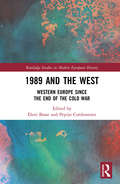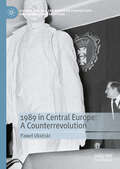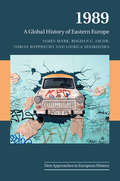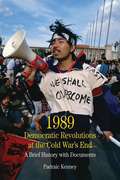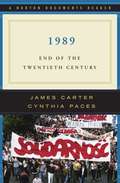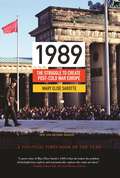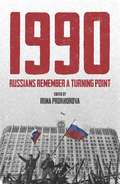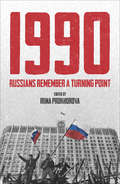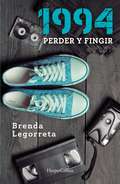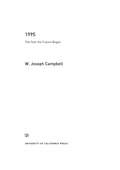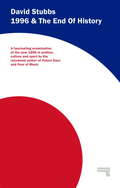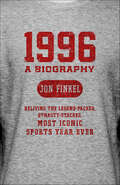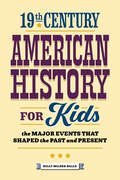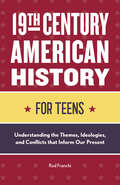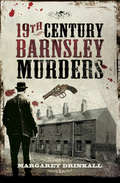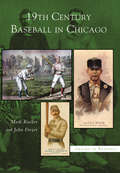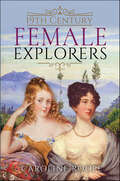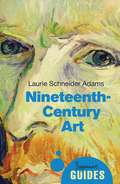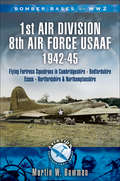- Table View
- List View
1989 and the West: Western Europe since the End of the Cold War (Routledge Studies in Modern European History)
by Eleni Braat Pepijn CorduwenerBack in 1989, many anticipated that the end of the Cold War would usher in the ‘end of history’ characterized by the victory of democracy and capitalism. At the thirtieth anniversary of this momentous event, this book challenges this assumption. It studies the most recent era of contemporary European history in order to analyse the impact, consequences and legacy of the end of the Cold War for Western Europe. Bringing together leading scholars on the topic, the volume answers the question of how the end of the Cold War has affected Western Europe and reveals how it accelerated and reinforced processes that shaped the fragile (geo-)political and economic order of the continent today. In four thematic sections, the book analyses the changing position of Germany in Europe; studies the transformation of neoliberal capitalism; answers the question how Western Europe faced the geopolitical challenges after the Berlin Wall came down; and investigates the crisis of representative democracy. As such, the book provides a comprehensive and novel historical perspective on Europe since the late 1980s.
1989 as a Political World Event: Democracy, Europe and the New International System in the Age of Globalization (Global Order Studies)
by Jacques RupnikThis book is not about the events of 1989, but about 1989 as a world event. Starting with the fall of the Berlin Wall and the collapse of the Soviet bloc it examines the historical significance and the world brought about by 1989. When the Cold War ended in Europe it ushered in a world in which the international agenda is set outside Europe, in America or Asia. The book critically examines and moves beyond some of the conveniently simple paradigms proposed in the nineties, by leading political scientists such as Fukuyama and Huntington, to show how the events of 1989 meant different things to different parties. This was an anti-utopian revolution, a symbol of the possibility of non-violent transitions to democracy, which raised the hopes of world-wide democratic changes. Contributors show how 1989 can be seen as the founding moment of a globalized world, but equal attention should be given to the dispersion of its meanings and the exhaustion of some of its main trends associated with the post-1989 era. Europe was reunited, yet it is in crisis. Twenty years on, global markets have brought about a global financial crisis. The fall of the Berlin Wall was celebrated as the advent of free movement in a world without borders. Now however, we can see that new borders, walls, fences have since been built. With an introductory essay by Vaclav Havel, 1989 as a Political World Event will be of interest to scholars of European Politics and International Relations.
1989 in Central Europe: A Counterrevolution (Central and Eastern European Perspectives on International Relations)
by Paweł UkielskiThe literature on the fall of communism contains numerous interpretations of the changes that took place in Central and Eastern Europe in 1989, while debates about how best to characterize the fall of the communist regimes have raged for many years. Researchers continue to ponder and argue over how ‘revolutionary’, as opposed to ‘evolutionary’ (or ‘reformatory’) these changes were. In this new study, author Paweł Ukielski proposes the term ‘counterrevolution’ to describe the historical process that took place and uses it as an analytical construct to better understand the crisis of Soviet communism and the subsequent transitions that took place.
1989: A Global History of Eastern Europe (New Approaches to European History #59)
by Tobias Rupprecht Ljubica Spaskovska James Mark Bogdan C. IacobThe collapse of the Berlin Wall has come to represent the entry of an isolated region onto the global stage. On the contrary, this study argues that communist states had in fact long been shapers of an interconnecting world, with '1989' instead marking a choice by local elites about the form that globalisation should take. Published to coincide with the thirtieth anniversary of the 1989 revolutions, this work draws on material from local archives to international institutions to explore the place of Eastern Europe in the emergence, since the 1970s, of a new world order that combined neoliberal economics and liberal democracy with increasingly bordered civilisational, racial and religious identities. An original and wide-ranging history, it explores the importance of the region's links to the West, East Asia, Africa, and Latin America in this global transformation, reclaiming the era's other visions such as socialist democracy or authoritarian modernisation which had been lost in triumphalist histories of market liberalism.
1989: Bob Dylan Didn't Have This to Sing About
by Joshua CloverIn a tour de force of lyrical theory, Joshua Clover boldly reimagines how we understand both pop music and its social context in a vibrant exploration of a year famously described as "the end of history." Amid the historic overturnings of 1989, including the fall of the Berlin Wall, pop music also experienced striking changes. Vividly conjuring cultural sensations and events, Clover tracks the emergence of seemingly disconnected phenomena--from grunge to acid house to gangsta rap--asking if "perhaps pop had been biding its time until 1989 came along to make sense of its sensibility." His analysis deftly moves among varied artists and genres including Public Enemy, N.W.A., Dr. Dre, De La Soul, The KLF, Nine Inch Nails, Nirvana, U2, Jesus Jones, the Scorpions, George Michael, Madonna, Roxette, and others. This elegantly written work, deliberately mirroring history as dialectical and ongoing, summons forth a new understanding of how "history had come out to meet pop as something more than a fairytale, or something less. A truth, a way of being."
1989: Democratic Revolutions At The Cold War's End - A Brief History With Documents (Bedford Cultural Editions)
by Padraic KenneyA series of democratic transformations in the 1980s ended the cold war and ushered in the present era. This volume by Padraic Kenney uses six case studies from this period — Poland, the Philippines, Chile, South Africa, Ukraine, and China — to explore common characteristics of global political change while highlighting the differing strategies and perspectives of the people who sought to free themselves from dictatorship. <p><p> A general introduction to the volume examines key trends in the decades leading up to the changes, tracing the paths that dictatorships and opposition movements took in their fateful confrontations. The first chapter with documents surveys the central ideas of this age of democratic, nonviolent revolution, and sets a framework for considering the case studies in the chapters that follow.
1989: End of the Twentieth Century (A Norton Documents Reader)
by James Carter Cynthia Paces1989: End of the Twentieth Century offers a comparative look at one of the most eventful years in world history. Nineteen eighty-nine marked the end of the Cold War, the fall of the Berlin Wall, the end of apartheid, and the "Beijing Spring" protests in Tiananmen Square. This engaging reader focuses on critical questions like "Why was the world caught by surprise by these events?" and "Why did the revolutions in Eastern Europe and in South Africa end in jubilation, while the protests in China ended in tragedy?" The original essay and the rich collection of documents in this volume explore both the long-term trends an the immediate causes that led to this series of events in 1989 that changed the world forever.
1989: The Struggle to Create Post-Cold War Europe - Updated Edition (Princeton Studies in International History and Politics #147)
by Mary Elise SarotteHow the political events of 1989 shaped Europe after the Cold War1989 explores the momentous events following the fall of the Berlin Wall and the effects they have had on our world ever since. Based on documents, interviews, and television broadcasts from Washington, London, Paris, Bonn, Berlin, Warsaw, Moscow, and a dozen other locations, 1989 describes how Germany unified, NATO expansion began, and Russia got left on the periphery of the new Europe.This updated edition contains a new afterword with the most recent evidence on the 1990 origins of NATO's post-Cold War expansion.
1990: Russians Remember a Turning Point
by Arch Tait Irina ProkhorovaAlthough 1989 and 1991 witnessed more spectacular events, 1990 was a year of embryonic change in Russia: Article 6 of the constitution was abolished, and with it the Party's monopoly on political power. This fascinating collection of documentary evidence crystalises the aspirations of the Russian people in the days before Communism finally fell. It charts - among many other social developments - the appearance of new political parties and independent trade unions, the rapid evolution of mass media, the emergence of a new class of entrepreneurs, a new openness about sex and pornography and a sudden craze for hot-air ballooning, banned under the Communist regime. 1990 is a reminder of the confusion and aspirations of the year before Communism finally collapsed in Russia, and a tantalising glimpse of the paths that may have been taken if Yeltsin's coup had not forced the issue in 1991.
1990: Russians Remember a Turning Point
by Arch Tait Irina ProkhorovaAlthough 1989 and 1991 witnessed more spectacular events, 1990 was a year of embryonic change in Russia: Article 6 of the constitution was abolished, and with it the Party's monopoly on political power. This fascinating collection of documentary evidence crystalises the aspirations of the Russian people in the days before Communism finally fell. It charts - among many other social developments - the appearance of new political parties and independent trade unions, the rapid evolution of mass media, the emergence of a new class of entrepreneurs, a new openness about sex and pornography and a sudden craze for hot-air ballooning, banned under the Communist regime. 1990 is a reminder of the confusion and aspirations of the year before Communism finally collapsed in Russia, and a tantalising glimpse of the paths that may have been taken if Yeltsin's coup had not forced the issue in 1991.
1990: Russians Remember a Turning Point
by Irina ProkhorovaAlthough 1989 and 1991 witnessed more spectacular events, 1990 was a year of embryonic change in Russia: Article 6 of the constitution was abolished, and with it the Party's monopoly on political power. This fascinating collection of documentary evidence crystalizes the aspirations of the Russian people in the days before Communism finally fell.It charts--among many other social developments--the appearance of new political parties and independent trade unions, the rapid evolution of mass media, the emergence of a new class of entrepreneurs, a new openness about sex and pornography and a sudden craze for hot-air ballooning, banned under the Communist regime.1990 is a reminder of the confusion and aspirations of the year before Communism finally collapsed in Russia, and a tantalizing glimpse of the paths that may have been taken if Yeltsin's coup had not forced the issue in 1991.
1994: Perder y fingir
by Thomas NelsonThe book narrates how, in a few months, Amalia transforms from a naive girl to a critical teenager and begins to see the country in which she lives from a new perspective.Amalia is a middle-class high school girl in Mexico from 1994. Attend a very rigid and traditional Catholic school. Along with Luisa, her best friend, Amalia begins to break the rules dictated by society: the parties begin and discover the boys of the opposite sex.Each of the characters in this story: her parents, her cousin Pablo, Luisa, her boyfriend Román, all contribute a small grain of sand in this awakening that leads Amalia to discover that the world is not how they wanted to tell it.There is a great nostalgia for the nineties today: music, fashion and television series constantly evoke this time. Brenda Legorreta's novel easily leads readers to that crucial year in the life of the country.El libro narra cómo, en unos cuantos meses, Amalia se transforma de chica ingenua a una adolescente crítica y comienza a ver el país en el que vive desde una nueva perspectiva.Amalia es una chica de preparatoria de clase media en el México de 1994. Asiste a una escuela católica, muy rígida y tradicional. Junto con Luisa, su mejor amiga, Amalia empieza a romper las reglas dictadas por la sociedad: comienzan las fiestas y a descubrir a los chicos del sexo opuesto. Cada uno de los personajes en esta historia: sus padres, su primo Pablo, Luisa, su novio Román, todos aportan un pequeño grano de arena en este despertar que lleva a Amalia a descubrir que el mundo no es como se lo han querido contar.Existe una gran nostalgia por los noventa en la actualidad: la música, la moda y las series de televisión evocan esta época constantemente. La novela de Brenda Legorreta lleva a los lectores con facilidad a ese año crucial para la vida del país.
1995
by W. Joseph CampbellA hinge moment in recent American history, 1995 was an exceptional year. Drawing on interviews, oral histories, memoirs, archival collections, and news reports, W. Joseph Campbell presents a vivid, detail-rich portrait of those memorable twelve months. This book offers fresh interpretations of the decisive moments of 1995, including the emergence of the Internet and the World Wide Web in mainstream American life; the bombing at Oklahoma City, the deadliest attack of domestic terrorism in U.S. history; the sensational "Trial of the Century," at which O.J. Simpson faced charges of double murder; the U.S.-brokered negotiations at Dayton, Ohio, which ended the Bosnian War, Europe's most vicious conflict since the Nazi era; and the first encounters at the White House between Bill Clinton and Monica Lewinsky, a liaison that culminated in a stunning scandal and the spectacle of the president's impeachment and trial. As Campbell demonstrates in this absorbing chronicle, 1995 was a year of extraordinary events, a watershed at the turn of the millennium. The effects of that pivotal year reverberate still, marking the close of one century and the dawning of another.
1996 And The End of History
by David Stubbs1996 And The End of History examines the year as it panned out in the UK not just in politics but in music, light entertainment and sport. It was the zenith of a decade which will go down as remarkably untroubled bymodern standards; following the collapse of the Berlin Wall, prior to 9/11, in which political conditions of peace and apparent economic prosperity created an overall mood of frivolity, postmodern anti-seriousness and a desire to get back to sunnier times before the grim onset of the strife-ridden 70's and 80's.
1996: Reliving the Legend-Packed, Dynasty-Stacked, Most Iconic Sports Year Ever
by Jon FinkelOn its 25th anniversary, relive the legend-stacked, dynasty-packed, most iconic sports year ever with the athletes, teams, and more whose collective influence affected every aspect of a generation of sports and pop culture fans—Jordan, Shaq, Iverson, Kobe, Gretzky, Tiger, Griffey, Jeter, Tyson, the Cowboys, the Yankees, the Bulls, The Rock, Stone Cold, Kentucky, Florida, Agassi, Graf, the Williams Sisters, Happy Gilmore, Space Jam, the Olympics in Atlanta, Muhammad Ali, the Magnificent Seven and more! Take a rollicking tour through the sports world of 1996, when debuts, comebacks, movies, and pop culture crossover changed the sports landscape forever. From college to the Olympics to the pros; from the NBA to golf, tennis, and boxing, 1996 was home to athletes and teams who were among the best marketed, most beloved, colorful, and greatest in history. In 1996: A Biography, sportswriter and author Jon Finkel uncovers the stories behind the stories while interviewing a who’s who of ’96ers to reveal in thrilling detail how their collective influence on sports and pop culture still resonates to this day. For those of us who remember when Iverson, Kobe, The Rock and Stone Cold, the MLS and the WNBA all debuted; when the US Women’s Olympic Gymnastics Team—the Magnificent Seven—won gold for the first time in history; when Mike Tyson and Magic Johnson made their comebacks; when MTV’s Rock n’ Jock, Michael Jordan’s Space Jam, and ESPN’s Dan Patrick and Stuart Scott were the bomb; when the Fun ’n’ Gun offense changed college football; when Ken Griffey Jr. ran for president (really! remember?); when Derek Jeter won Rookie of the Year, Favre marched to his first Super Bowl and Jerry Maguire had everyone saying “show me the money”. . . . 1996 is a sports time machine you’ve got to take for a spin.
1999
by Richard M. Nixon(back of book) As America's elder statesman of foreign relations, former president Richard Nixon provides a blueprint for world peace in 1999: VICTORY WITHOUT WAR. Drawing on a lifetime of experience, Nixon outlines the key international problems Western leaders must face as this century of "war and wonder" comes to a close-- and explains how the United States can meet these challenges to make the twenty-first a century of real peace. "A FOREIGN POLICY TOUR DE FORCE-A CRISP COGENT, CAUTIONARY TALE ABOUT AMERICA'S DIRECTION IN A TOPSY-TURVY WORLD ....IN UNCOMMONLY SENSIBLE LANGUAGE, THE MAN WHO OPENED CHINA TO THE WEST, WHO FORGED DETENTE WITH THE RUSSIANS. AND WHO NEGOTIATED THE FIRST NUCLEAR DISARMAMENT TREATY DEMONSTRATES WHY HE HAS EARNED THE TITLE OF AMERICAN ELDER STATESMAN.... AT HIS MOST ELOQUENT, NIXON ARGUES FOR AN AMERICA THAT REMEMBERS ITS IDEOLOGICAL EDGE, AN AMERICA THAT WILLINGLY AND CREATIVELY ACCEPTS THE BURDEN OF WORLD LEADER. NEVER HAS NIXON BEEN MORE FASCINATING, MORE FORTHRIGHT, MORE PERSUASIVE IN HIS THINKING ABOUT OUR POLITICAL AND MORAL IMPERATIVES!' -- The Columbus Dispatch printed in USA.
19th Century American History for Kids: The Major Events that Shaped the Past and Present (History by Century)
by Kelly Milner Halls19th century America comes alive for kids ages 8 to 12 History is an amazing teacher, helping kids understand why things are the way they are. Covering 1801 to 1900, this exciting, century-long journey offers young learners a look at 30 of the most definitive moments in American history—and how they made the United States what it is today. Get everything you could want from history books for kids ages 8-12 as this historical exploration immerses kids in the Louisiana Purchase, the rise of steam power, the Civil War, the growth of industry, and more. This standout among history books for kids ages 8-12 features: An event-focused approach—Show kids that learning can be fun as they discover what actually happened instead of just memorizing names and numbers. Connections for learning—Each event explains the link between then and now, making it easy for kids to see how history affects them. Kid-friendly coverage—Engaging bursts, boxes, and other extras call special attention to important individuals and information. There's never been a better way to introduce kids to the 19th century than with this engaging entry into history books for kids ages 8-12.
19th Century American History for Teens: Understanding the Themes, Ideologies, and Conflicts that Inform Our Present (History for Teens)
by Rod FranchiExplore the most important moments of the 19th century in this history book for teens Help teens learn how the United States grew out of the seeds of rebellion. This 100-year journey into American history covers the period following the American Revolution all the way through the Civil War, the Gilded Age, and more. 19th Century American History for Teens offers a compelling look into the United States' formative years and shows how they made the country what it is today. 19th Century American History for Teens features: Event-focused learning—This standout choice among history books makes it easy to understand 19th century American history with chapters that explain what happened during key events and how they impacted the rest of the century. Closer looks—Teens will dive deep into major political and social conflicts, the considerations that went into history-changing decisions, and more. Critical thinking opportunities—Exciting storytelling makes this book fun to read while still providing teens with the info they need to draw their own conclusions about how the 19th century shaped the modern day. Inspire teens to love learning about America's past with 19th Century American History for Teens.
19th Century Barnsley Murders: Pdf
by Margaret DrinkallDiscover the darker history of this South Yorkshire town with these true crime stories and photos. This book takes you on a journey into England&’s past, and into the gritty industrial town of Barnsley. With a variety of true-crime tales, it reveals not only the poverty and squalor in which many people of the time lived, but also the deep-rooted prejudices and double standards of the period. The crimes covered include poaching in the local area, a serious poisoning of bread and butter pudding at an eating house, and the tragic story of a man who was poisoned for a joke. More sinister happenings include a case of body snatching, which brought the whole town of Barnsley to a state of complete panic, the distressing murder of a child, a brutal attack on an elderly lady, and a woman who was shot down in the street by her former marine boyfriend. These macabre tales reveal a side of Barnsley that is not visible in the modern town of today. The intriguing narrative and in-depth coverage of Barnsley&’s criminal past makes compelling reading for those interested in both British history and the darker side of human nature.
19th Century Baseball in Chicago (Images of Baseball)
by Mark Rucker John FreyerThe Chicago area today hosts two of the most historic major league franchises and half a dozen minor or independent league teams. Baseball's roots run deep in the Windy City. Indeed, it was Chicago businessman William "I'd rather be a lamp-post in Chicago than a millionaire in any other city" Hulbert, who, according to baseball lore, staged the coup that in 1876 would put the National League on the map. The Chicago White Stockings (now ironically called the Cubs) were one of eight charter members, winning the inaugural NL Championship with such legendary names as A.G. Spalding, "Cap" Anson, and Roscoe Barnes.But The National Pastime arrived in Chicago well before the 1876 season, as is proven in this fascinating new book, 19th Century Baseball in Chicago, illustrated with over 150 vintage images.Any local fan of the modern game-whether the action takes place at the "Friendly Confines," 35th & Shields, or the cozy setting of a minor league ballpark out in Kane or suburban Cook County-will enjoy the wealth of information offered in 19th Century Baseball in Chicago.
19th Century Female Explorers
by Caroline RoopeAs any historian will testify, a nineteenth-century woman’s place was very much at home. Or was it? For a lucky (and plucky) few, who had a little determination, and the ability to withstand lice infestations, climbing mountains in corsets, rascally guides and occasional certain death - as well as the raised eyebrows of the society they left behind – then the world really was their oyster. In this lively re-telling of twenty-two extraordinary ladies who did just that, Caroline Roope invites you to journey to the further corners of the earth along with them. From humble missionary Annie Royle Taylor, who knew God would keep her safe, to the haughty aristocrat, Lady Hester Stanhope who defied convention and dressed as a Turkish man including pistol, knife and turban, their collective voices still resonate hundreds of years later. Drawing on their original accounts and archival sources, this expertly researched book brings to light a wealth of stories that are full of grit (sometimes literally), courage, and just enough humor to wish we’d been there with them on their adventures on the other side of the horizon. So, pack a suitcase, along with a ‘good thick skirt’ à la Mary Kingsley, and prepare to go beyond the garden gate…
19th Century Girls And Women (Historic Communities)
by Bobbie KalmanDescribes various aspects of the lives of women and girls during the 19th century, including their lack of educational opportunities, restrictive clothing, pastimes, courtship and marriage, and limited employment prospects.
19th-Century Art: A Beginner's Guide (Beginner's Guides)
by Laurie Schneider AdamsMunch's The Scream. Van Gogh's Starry Night. Rodin's The Thinker. Monet's Water Lilies. Constable's landscapes. The 19th century gave us a wealth of artistic riches so memorable in their genius that we can picture many of them in an instant. At the time, however, their avant-garde nature was the cause of much controversy. Professor Laurie Schneider Adams vividly brings to life the paintings, sculpture, photography and architecture, of the period with her infectious enthusiasm for art and detailed explorations of individual works. Offered fascinating biographical details and the relevant social, political, and cultural context, the reader is left with a deep appreciation for the works and an understanding of how revolutionary they were at the time, as well as the reasons for their enduring appeal.
1: The Sub-Two-Hour Marathon Is Within Reach?Here?s How It Will Go Down, and What It Can Teach All Runners about Training and Racing
by Philip MaffetoneWhat will it take to run a marathon in less than two hours?The world's fastest times for the marathon have been dropping since the distance of 26.2 miles was made official nearly one hundred years ago. But after a noticeable decline that occurred for a half century, the times, while still edging lower, have stalled several minutes north of two hours for the past decade.For the first time, 1:59 examines what it will take for an elite distance runner to go sub-two hours. It will require more than raw talent, optimal body size, and great athletic genes. In order to become marathon's Roger Bannister and smash this elusive record, this runner must follow a healthy diet and an individualized training regimen that takes advantage of specific environmental factors ("live high, train low"). Because precious seconds count over each mile run, other critical considerations include improved running form and economy, sharpened mental focus, and wearing the right type of racing flats (or even going barefoot).The athlete who finally breaks distance running's most tantalizing barrier will become a worldwide celebrity overnight. Will the runner be a Kenyan, an Ethiopian, an American, or a marathoner from another country? And how soon will it happen?By providing a unique window into the highly competitive world of elite marathon running, this book also allows running enthusiasts to have a thorough understanding of the true potential of endurance athletes. And in turn, they can apply the same training and racing principles discussed in 1:59 to their own running, whether it's a 10K, half marathon, marathon, or ultramarathon.
1st Air Division 8th Air Force USAAF 1942-45: Flying Fortress Squadrons in Cambridgeshire, Bedfordshire, Essex, Hertfordshire and Northamptonshire (Aviation Heritage Trail Ser.)
by Martin W. BowmanAs part of the AHT series, the airfields and interest in this book are concentrated in a particular area—in this case Cambridgeshire, Bedfordshire and Northamptonshire. Constituted as the lst Bombardment Division on 30 August 1943 the unit was activated at Brampton Grange, Huntingdon on 13 September 1943. It was assigned to the Eighth Air Force and redesignated lst Air Division in December 1944. The division served in combat in the European theater of Operations from September 1943 until April 1945. All squadrons within the division flew the long-distance Boeing B–17 Flying Fortress heavy bomber on raids into occupied Europe and Germany. There were forty-eight squadrons in the division based at Bassingbourn, Ridgewell, Nuthamstead, Podington, Chelveston, Thurleigh, Molesworth, Kimbolten, Grafton Underwood, Polebrook, Deenethorpe and Glatton.As part of the AHT series, the airfields and interest in this book are concentrated in a particular area—in this case Cambridgeshire, Bedfordshire and Northamptonshire. Constituted as the lst Bombardment Division on 30 August 1943 the unit was activated at Brampton Grange, Huntingdon on 13 September 1943. It was assigned to the Eighth Air Force and redesignated lst Air Division in December 1944. The division served in combat in the European theater of Operations from September 1943 until April 1945. All squadrons within the division flew the long-distance Boeing B–17 Flying Fortress heavy bomber on raids into occupied Europe and Germany. There were forty-eight squadrons in the division based at Bassingbourn, Ridgewell, Nuthamstead, Podington, Chelveston, Thurleigh, Molesworth, Kimbolten, Grafton Underwood, Polebrook, Deenethorpe and Glatton.
